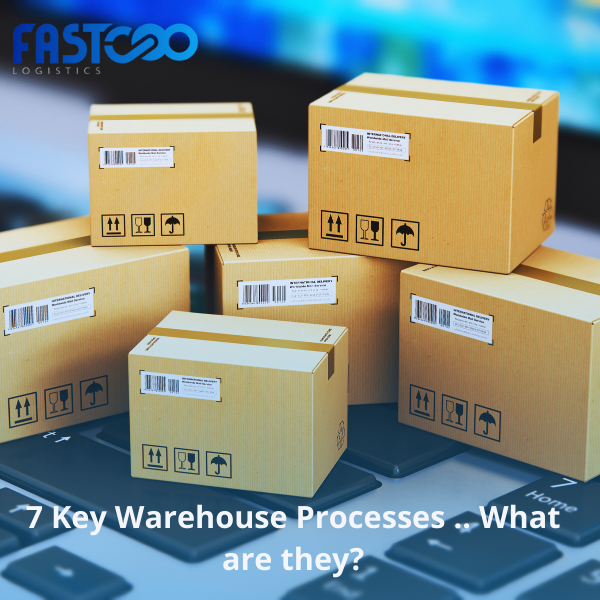7 Key Warehouse Processes .. What are they?

Warehouse Processes is one of the most important support functions in organizations and companies; Because it plans and organizes the storage and maintenance of materials and supplies the customers or the main departments within the company with their needs in a timely manner to ensure the continuation of their work efficiently and without interruption, and in this article we will learn together about 7 Key Warehouse Processes.
What are Warehouse Processes ?
A warehouse is a commercial building for storing goods, and Warehouse Processes are used by manufacturers, suppliers, as well as exporters and wholesalers, and are usually large flat buildings in industrial areas, and the warehouse is provided with loading platforms for loading and unloading goods from trucks.
7 Key Warehouse Processes
Although all Warehouse Processes differ in the way each process is performed physically and controlled electronically, there are 7 main processes that all warehouses share, and below we will show 7 Key Warehouse Processes:
1. Receiving
Receiving means handling the products in a warehouse and on a specific system, and those products or items may be large or small, and one of the best ways to deliver the products is the (ASN) method, which means prior shipment notice. If the delivery service is using (ASN), operators can scan bar codes. For the shipment and receipt of goods or items from the order itself,
2. Put-Away
Good systems motivate employees, so if there is stock in preparation waiting to be transported to the storage location, the cleaners scan the barcode of those goods to be put away, and at this stage the system will direct the storage personnel to deliver the goods to the appropriate storage location.
When the products or goods arrive at their location, the operator will either allow the barcode of the goods or manually verify that the goods are in the correct place.
3. Picking
After the elements are received, they are downloaded and then picked, and this Picking may be separate or in a group, and in general there are two main types of selection, namely:
- Basic selection: in which the selection is done for the first time and for the last time as well, where selection is made at the beginning on the packing table, then shipping and dispatching, so the first selection becomes the last also.
- Secondary selection: selection is done for the second time, and after the spread of online sales and e-commerce, a large number of companies are conducting secondary selection processes largely.
With the increasing sales of items over the Internet, companies are increasingly installing picking devices on belts and walls, in order to handle the largest possible number of orders.
But in general, selection uses a large amount of resources, and smart picking systems and WMS are essential for large and complex companies in their operations.
4. Packing
Packaging is an extension of the selection process, which must be managed and handled with great care in Perfect order to ensure that orders will be complete and accurate. There are many ways in which goods are packed, and the following are the best rules by which you can reach a successful packing process, and they are:
- That the selected goods and products be traceable in terms of the location from which they were previously picked, with the importance of having the relevant usage dates, as well as batch dates and codes.
- The necessity to verify accuracy and quality assurance in the process through various verification processes.
- Attempting to merge the goods that were picked from multiple areas within the warehouse, while trying to manage the system more easily in order management to ensure the completion of the order.
- All goods must be packed according to volume, quantity, required temperature, value, as well as legislative requirements.
- The need for shipments to be also traceable through the system itself.
5. Dispatching
There is the so-called art of successful dispatch, an art that many companies are ignorant of, and which means the ability to prepare goods for timely departure for carriers to load their trucks. Therefore, the manager must balance the times of delivery of goods, as the arrival of goods too early or too late will result in a lot of chaos, so a large number of companies resort to picking and packing in waves in line with the delivery methods that have been identified, or types Transportation companies.
6. Returns
Returns are the most complex part of any business, so there has to be a defined process for recording the entire transaction accurately and reliably.
We find that every company wishes its returns to disappear, and due to the e-commerce revolution, the volume of returns is increasing for many companies, and there are a number of things that you must do when processing returns, namely:
- When a customer returns goods, he must obtain permission from the Return Department, in which the item being returned and the reason for returning it shall be clarified as well.
- The necessity that all returns can be tracked easily, through its invoice.
- The company should set up a returns process so that it specifies in advance what to do with the returned goods.
7. Value-Adding
Added value is an economic term referring to the value of the transformation that occurred in a substance as a result of a specific production process.
Value added is also related to performing the work itself on a product, and the process of adding value can be more complex, especially when many different elements are combined to form a new product.
But with the tremendous development witnessed by the current era, and modern technical methods, systems have evolved to help complete the processes of adding value.




